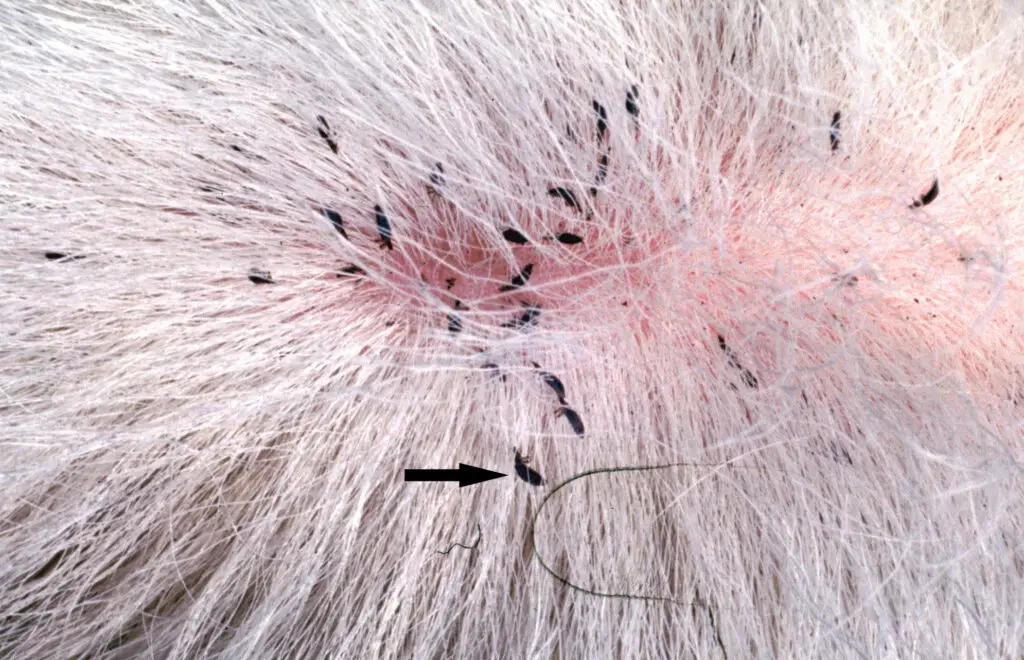
Cattle Lice! your cattle are always on the move, rubbing against fences, scratching relentlessly, and patches of hair are starting to disappear. If this sounds familiar, you’re probably dealing with the cattle lice in your herd. These tiny parasites may be small, but they can cause major irritation and even economic losses for your cattle business. But don’t worry, you can kick those lice to the curb! Let’s dive into understanding cattle lice and how to get rid of them quickly.
What are Cattle Lice?
Cattle lice are wingless insects that spend their entire lives on your cattle. They come in two main varieties: chewing lice and sucking lice. Chewing lice munch on hair, skin, and debris while sucking lice pierce the skin to suck blood. Yuck! Both types cause intense itching and discomfort for your livestock.
Cattle Lice Symptoms

The most obvious signs of a cattle lice infestation include:
- Constant rubbing and scratching: Cattle will rub on anything they can to get relief.
- Hair loss and rough coat: Look out for patches of missing hair and an overall lackluster appearance.
- Visible lice: If you part the hair, you might actually see the tiny critters, especially in areas like the back, shoulders, and neck.
- Reduced weight gain and milk production: Heavy infestations can really take a toll on your cattle.
Where Do Cattle Lice Come From?
Cattle lice are experts at spreading. They transfer through direct contact between animals, so they thrive in crowded conditions or when cattle are rubbing noses. Lice can also linger in bedding, brushes, and other shared equipment for a while. That’s why it’s important to treat your entire herd at the same time.
The Cattle Lice Life Cycle
Understanding how cattle lice reproduce is key to getting rid of them. Adult lice lay eggs (called nits) that glue themselves onto cattle hair. Within a few weeks, those nits hatch into nymphs, which quickly mature into adults ready to lay more eggs. The whole cycle can take less than a month, so you can see how populations can explode!
Cattle Lice Treatment
Now, let’s get to the good part – saying goodbye to those pesky lice! There are several effective treatment methods:
- Cattle Lice Pour-On: These products are applied directly along the animal’s backline. They’re convenient and absorb into the skin for longer-lasting protection.
- Cattle Lice Spray: Sprays offer full-body coverage, but often require more work to apply thoroughly.
- Ivermectin for Cattle Lice: Ivermectin is found in injectable, pour-on, and oral treatments. It’s a versatile option that tackles both internal and external parasites, including lice.
- Diatomaceous Earth for Cattle Lice: While DE can have some effect, it’s mostly a preventative measure and shouldn’t be relied on for treating heavy infestations.
Best Cattle Lice Protection
The best way to protect your herd is a proactive approach:
- Treat the whole herd: Don’t just treat the itchy ones!
- Timing is key: Fall or winter treatments are often recommended to target lice populations before they peak.
- Rotate products: Prevent lice from becoming resistant to specific treatments.
How to Get Rid of Cattle Lice
Here’s a quick guide to eliminating cattle lice:
- Choose your product: Talk to your veterinarian for customized product recommendations
- Read and follow the label: Application instructions and safety precautions are crucial.
- Treat everyone: Leave no cow untreated!
- Repeat if needed: Some products may require a follow-up treatment.
- Clean up: Disinfect shared equipment and consider treating bedding areas.
Absolutely, here’s the next part of the blog post:
What Does Cattle Lice Look Like

Knowing what you’re looking for helps confirm a lice problem. Different species of cattle lice vary slightly, but here’s a general idea:
- Size: Tiny, about the size of a sesame seed or smaller.
- Color: Can range from yellowish-brown to reddish or gray.
- Shape: Chewing lice have broader heads, while sucking lice have narrower, more pointed heads.
Cattle Lice Scientific Name
It’s time for a bit of scientific lingo. The most common cattle lice species are:
- Biting Lice:
- Bovicola bovis (cattle biting louse)
- Sucking Lice:
- Linognathus vituli (long-nosed cattle louse)
- Haematopinus eurysternus (short-nosed cattle louse)
- Solenopotes capillatus (little blue cattle louse)
FAQ Section
Can Cow Lice Spread to Humans?
The good news is NO! Cattle lice are species-specific, meaning they only like cattle and won’t infest humans.
How to Remove Cow Lice?
The treatment options we discussed earlier (pour-on, sprays, ivermectin) are the most effective ways to remove cattle lice.
What is the Most Effective Lice Treatment for Cattle?
There’s no single “best” treatment. It depends on your herd size, time of year, and your veterinarian’s recommendations.
What is the Best Insecticide for Lice?
Commonly used insecticides for cattle lice include synthetic pyrethroids, organophosphates, and macrocyclic lactones (like ivermectin).
Is Ivermectin Best for Lice?
Ivermectin is a highly effective option for treating lice, but other choices exist as well.
Conclusion
Cattle lice are a nuisance, but they’re a manageable problem. By understanding how lice spread, recognizing the symptoms, and choosing the right treatment methods, you can restore your cattle’s comfort and protect your herd’s health.
Remember, if you’re unsure about which treatment is best for your situation, always consult your veterinarian. They’ll help you develop a targeted plan to get rid of cattle lice once and for all!
Have you ever dealt with cattle lice? Share your experiences and tips in the comments below! Let’s help each other keep our herds healthy and itch-free.
